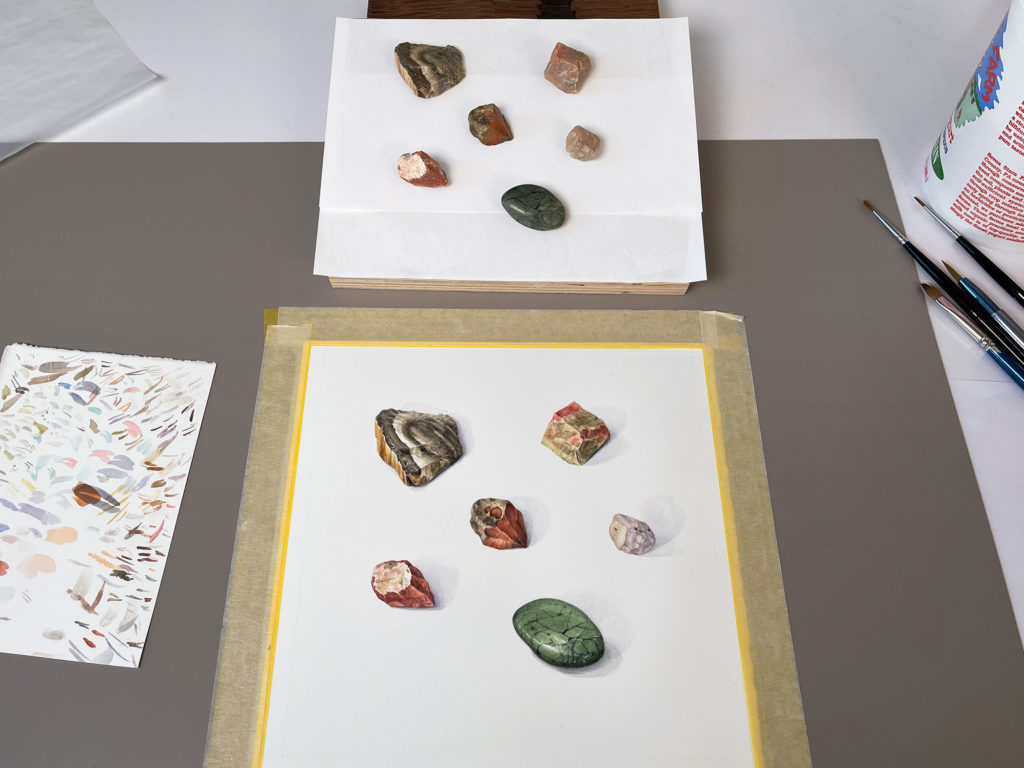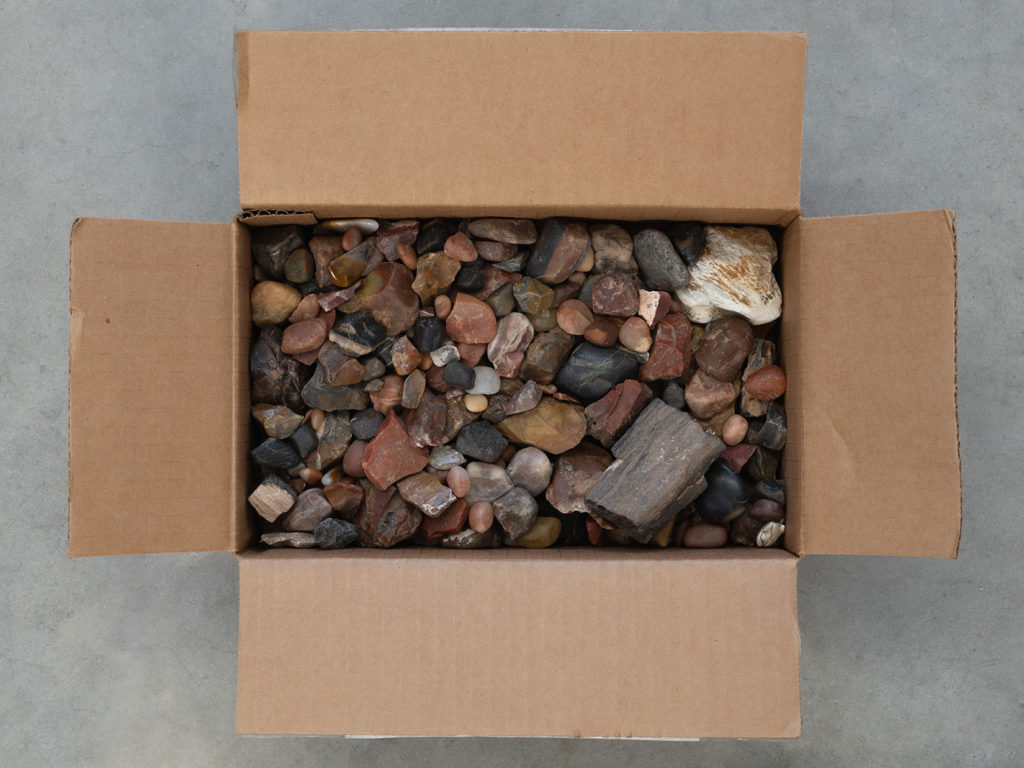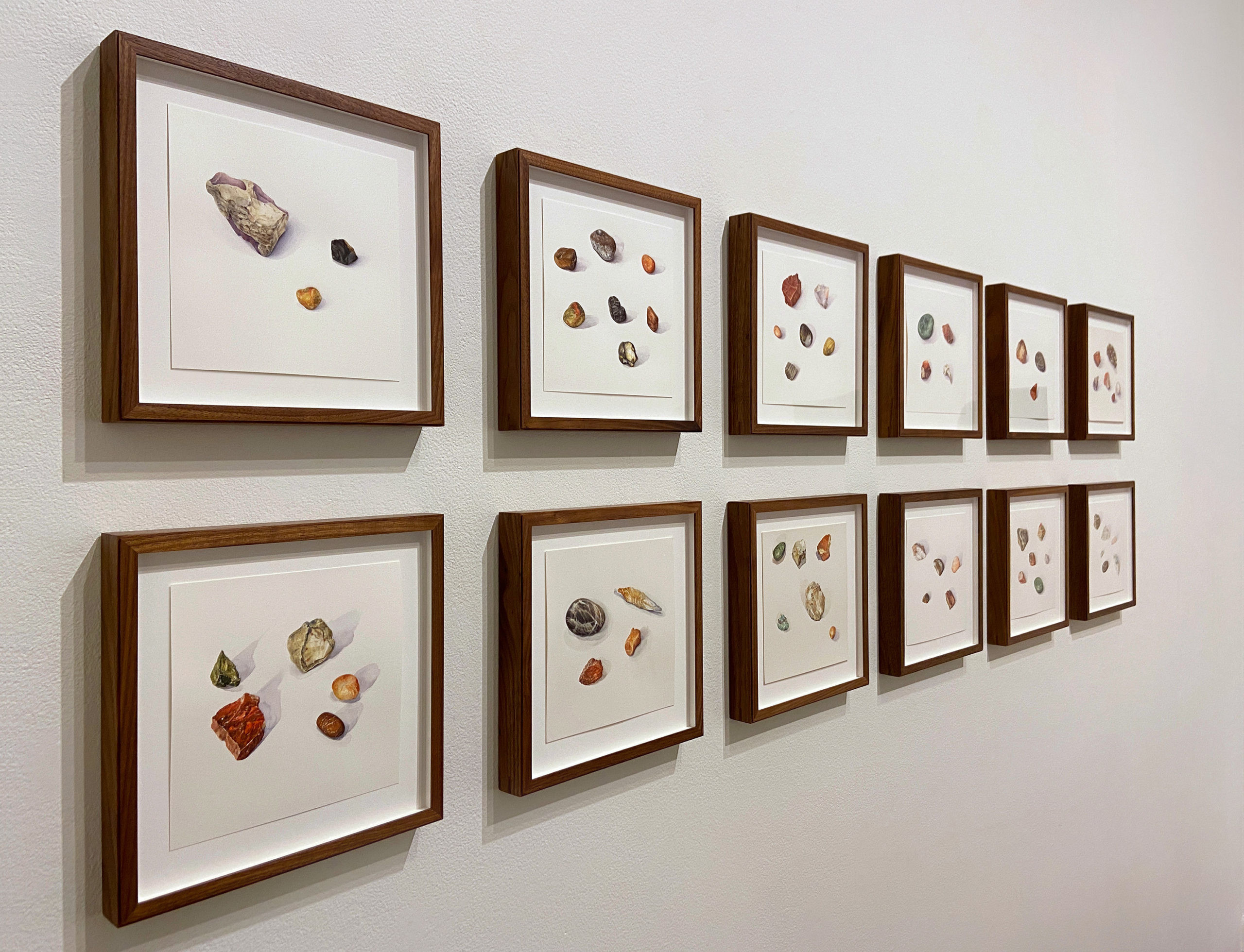February 15, 2023
Artist Alison Moritsugu’s work explores our relationship with nature and how the stories we tell about landscapes—often idealized to hide what lies beneath the surface—shape our conceptions of the world around us. Her recent exhibition at the Brattleboro Museum, “Moons and Internment Stones,” features a series of paintings of rocks her grandfather collected within the Santa Fe internment camp and the moon that connects Moritsugu, her grandfather, and her family across time and place.
Moritsugu joined Densho Community Curator Erin Shigaki for a conversation about stories passed down between generations, finding meaning in everyday objects and landscapes, and of course, Grandfather Moritsugu’s rocks. Below is an excerpt of their discussion, edited for length and clarity. Watch the full recording here.
Erin Shigaki: Hi, everyone. I am here in the capacity of Densho’s community curator for the year, and I really have enjoyed this program because it acknowledges the role that art plays in helping us all remember and heal from the dark parts of our past. So Alison, could you give us further background on your grandfather Moritsugu and his history especially as it relates to World War II?
Alison Moritsugu: Well, I’m going to go back prior to Pearl Harbor. In Hawai`i, the Japanese were moving across the Pacific and people in Hawai`i realized that there was a real threat, so there was this build up, even prior to Pearl Harbor, to fortify the islands. In fact, my father worked as a carpenter’s assistant in the summer before Pearl Harbor helping to build Air Force hangars, helping to build housing for military at the Kaneohe Naval Air Station, which was not too far away from where he lived. And then on Pearl Harbor, December 7, 1942, it was a Sunday. And my dad, I remember him telling me on Sundays the military would do all this practicing. He remembers all these planes flying towards Kaneohe Air Station that day and he thought, “Wow, they’re really doing a big practice today.” Then he saw smoke coming from the hangars and he realized that it wasn’t a practice but it was actually an attack. Shortly after Kaneohe Naval Air Station was bombed, Pearl Harbor was bombed. And then the next day, Hawai`i was no longer under civilian rule. It was under military rule.
So everything changed. The money changed. My grandfather could no longer fish—that was how he made a living—so he ended up becoming a carpenter to help build machine gun nests. And my father made money stringing barbed wire along the beaches in case there was an invasion from the Japanese. It was not until April 1943 that military officials arrested my grandfather. They took him home and my dad said that they separated my grandmother from him and they told my grandmother to pack a suitcase with some clothes and toiletries because they were going to take my grandfather away for a few days. And he had his young children—I think they were ages two, five and seven. They told them that they were taking my grandfather to a party.
What ended up happening was he was taken to Sand Island detention camp. He was there for three months. And then he was sent to Santa Fe internment camp, which was run by the Department of Justice, and he was there for almost three years. My grandmother, because she had eight kids, had to figure out a way of supporting the family during this time. I know, especially for my grandfather, my father said he was just really worried about how they were going to eat and live. He was released in 1945 and he returned back to Hawai`i with his box of rocks and a box of journals.

ES: Thank you. I think there’s a lot of difficult parts of the story, but that family separation piece that happened at the very front of it is just, it’s really chilling and rhymes a lot with things that are happening now. Your grandfather Moritsugu passed away several years before you were born, right?
AM: Yes, it was 11 years before I was born.
ES: Okay, so I wonder how you learned these things about him and the war years?
AM: Well, I sort of laugh because it’s a common story with a lot of Japanese American families that this really wasn’t talked about much. I just never knew there was anything like these incarceration camps growing up. I was a teenager when that movie “Farewell to Manzanar” came out. I think it was 1976, and we watched it as a family and I remember thinking, “What? I can’t believe that happened.” It was really unsettling for me. I found out that on my mom’s side of the family, she had a cousin and that family lost their house and their livelihood in California. But at no point did we have a family discussion and at no point did my father say, “Oh, that happened to your grandfather.” It was sort of like, “Okay, that happened. Push it aside.”
And then when my father retired, he wrote his autobiography, and there was a section about World War II and what happened to the family. So that’s when I got more information about the incarceration. Then in 2011, when my dad was 86 years old, Densho interviewed him to get his oral history. After watching those interviews, I learned even more. That was really great. And those interviews are really invaluable to me.
ES: Yeah, I always think about how the Nisei—the second generation, the American-born generation—they were supposed to be the ones who had this great flourishing of self, but it was suppressed by this incarceration experience. And so now, us Sansei and Yonsei are asking questions, and really trying to understand what it means for this history to be seen. What it means for us and what it means for our ancestors too. And I think that probably leads into my next question, which is… the rocks. Why the rocks, Alison? Tell us more about why you decided to paint these rocks.
AM: [Laughs] Okay, the rocks. I’ll tell you a little bit about these rocks. I knew that they existed because my dad had once showed me. He pulled down this box from the garage and it was these rocks wrapped in newspaper, put in a plastic bag, tied with some string, put in another plastic bag, put in a box, and kept on the third shelf in the garage. And so I knew they existed and I remember thinking it would be great if someday I could paint them. I thought, “Oh, that’d be really cool to paint them because my grandfather used to own them.”
I spoke to my aunt a couple months ago, and she said she remembers the rocks when my grandparents were moving out of my uncle’s house. She said, “I remember them. I have this vision of them in the trunk of a car. And I remember talking to your uncle and we were saying, who’s gonna want a box of rocks? There’s nothing special about these rocks.” And they said Toshio, my father, he’d want them. So they gave them to my father who then stored them in the garage for all those years.

So they arrived in a plastic bag, and they were all dusty. They were mixed in with some dirt and they really looked like a bag of just brown and red gravel. And I started to think about the rocks and the natural environment they came from, and about the landscape that they came from. Then I started to think about my grandfather, and I was wondering what qualities of these rocks caught his interest. Some are really obvious, some are just really beautiful and crystalline, but some are really simple and kind of boring and unassuming. And you know how you walk on the beach and you pick up a pebble or shell out of all the millions of pebbles on that beach? What is it about that one stone that calls out to you? I was thinking about why he picked these stones and not other stones, and I felt by studying them and being with them, I might be able to get some understanding of who he was.
ES: Thank you. I just think it’s really wonderful that you were able to fuse yourself with some of the spirit of your grandfather. I really appreciate your work.
–
This is the first in a series of artist profiles produced by Densho’s first Community Curator. Learn more about the community curator and artist-in residence programs here.
[Header: Installation view of the Moons and Internment Stones exhibition at the Brattleboro Museum & Art Center, 2022-2023. Courtesy of Alison Moritsugu.]
